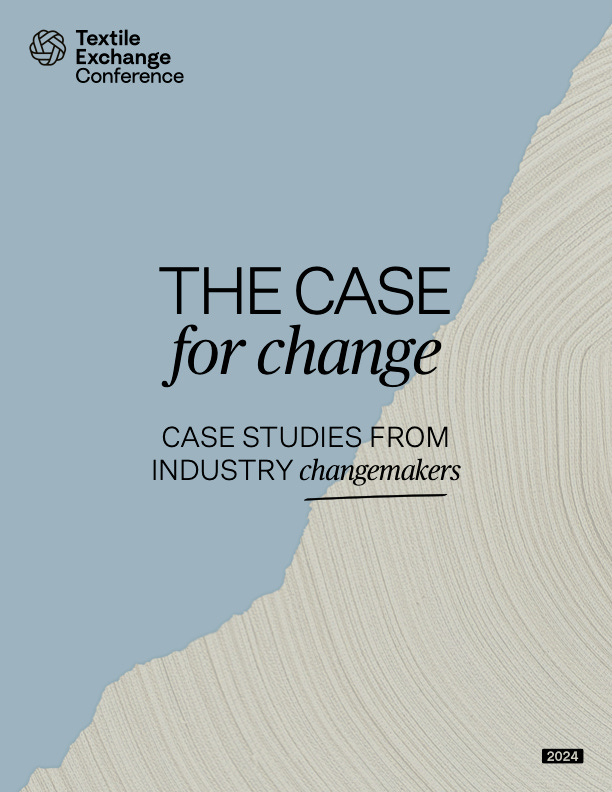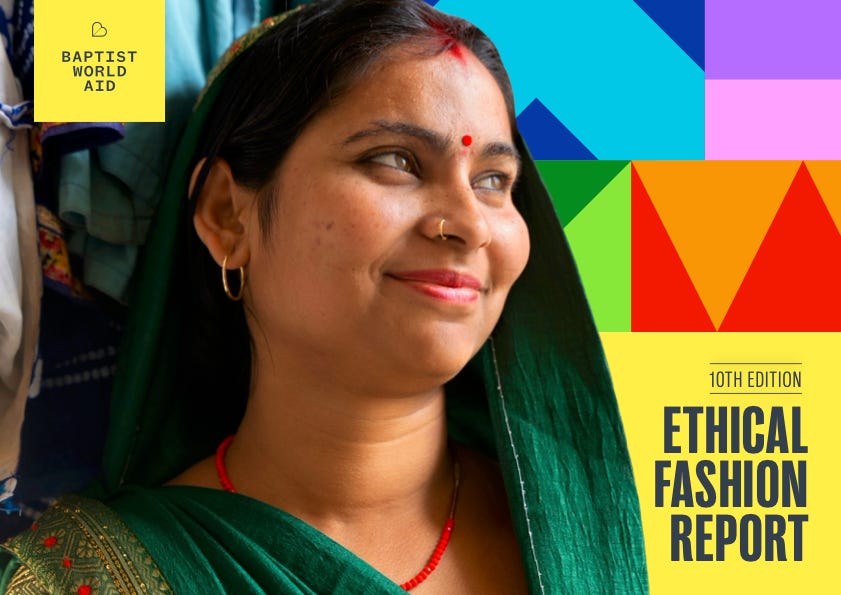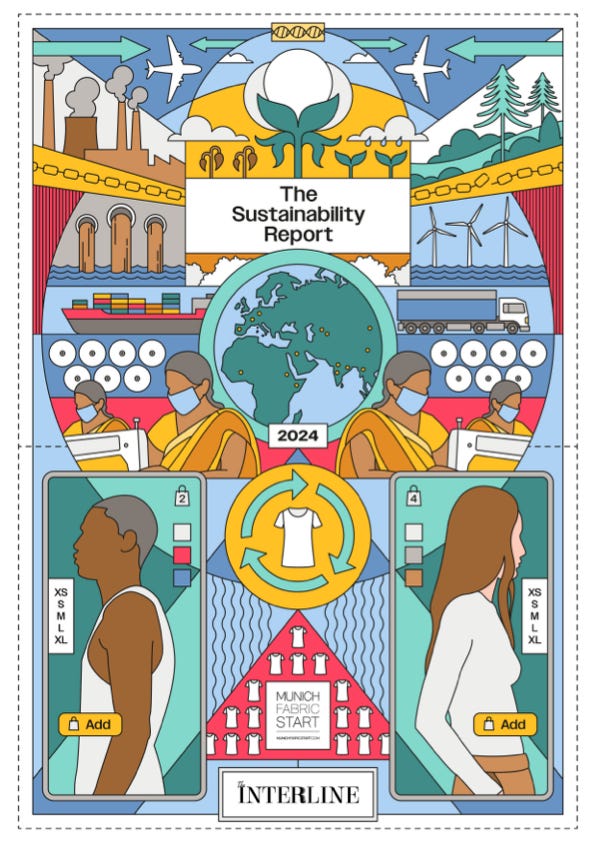October in Fashion, Condensed.
Four lessons from the Textile Exchange 2024 conference, the Case for Change case studies, and fashion's overlooked child labour problem.
Hello there,
Last week, I was in Pasadena, California at the Textile Exchange conference — an industry meeting of more than 1000 experts, from farmers to global brands, across fashion’s global supply chains.
After moderating sessions on traceability beyond compliance or material standards and certifications, I sat in on keynotes from thought leaders like Andrew Winston and Katharine Wilkinson, and panels that covered degrowth, the business case for climate action, sustainability communications, and organisational buy-in for sustainability initiatives. During the week, I noted down ideas that struck a chord with me, which I wanted to share and expand on below.
There is a leadership crisis at the heart of the climate crisis
When it’s put like this, the above statement is pretty obvious. But it’s a powerful reminder that if global industries and governments had more ambitious, forward-thinking leaders that weren’t completely driven by greed and growth, then things would look different. Recognising that leadership is a critical factor in change-making should empower us to vote for the leaders that represent our values and nurture future leaders who think differently about the way our world could work.
Relationships between people are critical to imagining a new future
Eleanor Harry from HACE, a child labour expert I interviewed for my Vogue Business story below, told me in our interview last month: “Climate change and environmental issues have overshadowed social ones. But people deforest. You want to protect trees? You have to involve people. You can't treat these two things as if they're separate.”
It is so important to remember that people are at the heart of everything — for better or worse. By building connections and long-term relationships with people, so much can be achieved. For example:
Building and maintaining trusting relationships between brands and manufacturers unlocks opportunities to invest in facility-level improvements and give manufacturers consistency and stability they desperately need
Establishing pre-competitive working groups between brands to share resources, insights and goals means the risk and burden is shared, and everyone is accountable for action.
Get your boots dirty
This is a lesson I’m making my goal for 2025 (after I buy some farm-appropriate boots, that is.) Farmers must be included in collaboration as they often have generations of knowledge, data and experience that can inform solutions to have the greatest impact. The vast majority of decarbonisation in fashion supply chains needs to happen in partnership with raw material producers. The issue is, the industry rarely has any contact with these tiers in their value chains. This really is a call to action to find, listen to, and work with producers.
Invest in your climate courage
During a plenary with climate author Katharine Wilkinson, a straw poll of the audience revealed that very few people identified with the statement: I am able to work with climate emotions and access healing and rest. For a group of people at the forefront of fashion’s sustainability work, this is concerning.
I recently interviewed Nicole Rycroft, the founder of non-profit Canopy which is working to restore the world’s forests and biodiversity. On the topic of how Canopy supports its workforce to manage the challenging emotional impacts of their work, she said that “we spend so much time in the context of what’s being lost that we make sure that our team is encouraged to spend time immersed in nature.” Spending time in nature can be such a powerful way to refill our climate courage cup and remind ourselves of the why behind the work.
On that note, see you next month.
Meg
Things I Did Write
The Overlooked Child Labour Problem in Fashion’s Supply Chain for Vogue Business
The US Department of Labor has named major fashion-sourcing regions — India, China, Turkey, Vietnam, Azerbaijan, Benin, Brazil and Egypt, among others — as hotspots for child labour, with cotton, gold, rubber and leather among the highest-risk materials. With child labour figures expected to increase and forced labour regulations on the horizon, experts are urging the fashion industry to clean up its murky supply chains and eradicate the pervasive issue once and for all.
The Case for Change: Case Studies from Industry Change-makers for Textile Exchange*
With over 16 interviews across five case studies, the Case for Change presents thought leadership on topics including textile to textile recycling legislation, natural capital and regenerative agriculture, next-gen material partnerships, and more. We spoke to brands like Ralph Lauren, Eileen Fisher, and Everlane, innovators like Ambercycle, Circ, and Re&Up, legislators and policy experts, as well as farmers and agricultural experts to present viewpoints from across the supply chain.
*The case studies are accessible to Textile Exchange members only.
Things I Didn’t Write
Inside the Lives of Ready Made Garment Workers by Tahira Shamsi Utsa for the Daily Star
Why, Exactly, Is Polyester So Bad for the Environment? by EcoCult
High-End Fashion No More Durable Than Fast Fashion, Report Discovers by Brooke Roberts-Islam for Forbes
Can Trashie Solve Fashion’s Waste Problem? by Sophie Benson for Atmos
For Companies in China, Pulling Out of Xinjiang Poses ‘Messy Dilemma’ by Keith Bradsher and Ana Swanson for the New York Times
How a Harris Vs Trump Administration Would Impact Fashion By Madeleine Schulz for Vogue Business
After Years of Pressure Levi’s Commits to Protecting Workers in Pakistan by Clean Clothes Campaign
Gen Z Supports Sustainability – and Fuels Ultra-fast Fashion. How Does That Work? by Amanda Spry and Marian Makkar for the Conversation
Fast Fashion’s Impact on Local Designers and Retail Brands by Lucianne Tonti for the Saturday Paper
The To-Do List
The Stories We Wear short film by Isa Rao based on research by Erica Charles
Erica Charles, Lecturer and Programme Leader at the Glasgow Caledonian University released this short film in line with Anti-Slavery Day in October. It tells the story of a garment worker in Leicester, informed by a series of interviews and in-depth research Erica conducted on the city’s garment industry.
I hosted a panel discussion on this topic with Erica and other experts in October, and what struck me was that after the big Boohoo scandal in 2020, not much has changed in Leicester for garment workers. In fact, because so many brands pulled out of the city, there are now more unemployed garment workers, fewer jobs, and worse working conditions. It goes to show the power and responsibility that brands have to rectify and remediate issues instead of running away from them.
Baptiste World Aid’s Ethical Fashion Report 2024
This new report by the Australian non-profit assessed 120 companies representing 460 brands, revealing an average score of 31/100 across policy and governance, traceability, human rights, worker empowerment and environmental sustainability. Some interesting results in the ranking of brands — worth a read.
The Interline’s 2024 Sustainability Report
Always an interesting report from the Interline, covering topics from China’s sustainability efforts to the just transition of the circular economy.








